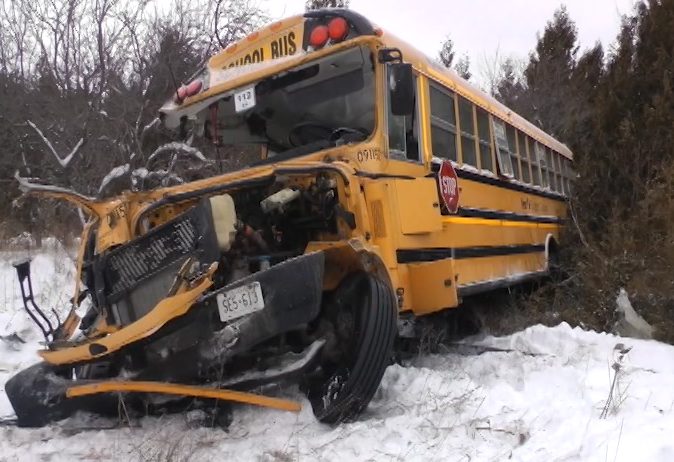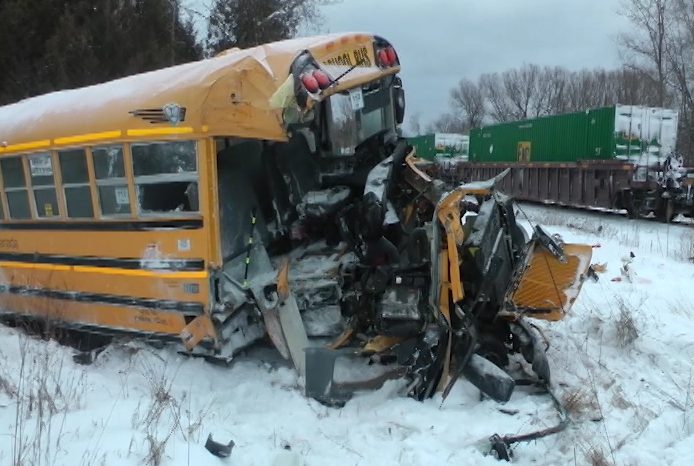The Transportation Safety Board of Canada says multiple factors led to a collision involving a school bus and freight train near Colborne, Ont., a year ago.

Three people — a driver, adult monitor and a high school student — escaped the bus before it was struck by an eastbound Canadian Pacific freight train at the railway crossing at Town Lind Road around 7:30 a.m. on Feb. 13, 2017.
The TSB says its investigation probed the requirement for school buses to stop at all railway crossings, driver practices, winter tire performance data and deficiencies in company procedures for railway crossing emergencies.
TSB investigators say the bus stopped as required at the railway crossing but then got stuck in the accumulated snow after the driver slowed the bus to look both ways a second time while driving over the crossing.
“Given that the bus had previously come to a stop and that snow had accumulated on the road, the rear tires could not provide the traction required to propel the bus up the incline,” the TSB report states.
“The driver believed that crossing slowly and looking in both directions once on the tracks was safer, despite company training instructions to move quickly and without hesitation across the tracks.”

The TSB says yearly company evaluations did not identify the driver’s practice of reducing speed when travelling over crossings.

Get breaking National news
The report also discovered all emergency lights and bells were operating at the time of the collision that saw the bus and signal mast destroyed and the locomotive sustain minor damage.
However, investigators said although the driver followed company procedures and notified the dispatcher of the emergency, they said the driver was delayed in relaying the location of the crash despite the information being posted at crossings.
“Notification time would likely have been reduced had the information posted at the crossing been provided immediately to the dispatcher,” the TSB report states.
“If emergency response procedures of commercial road transport operators do not include immediate notification to the railway company using the emergency information posted at crossings, opportunities to avoid crossing collisions will be missed.”
The TSB also compared the collision to others where buses stopped in advance of crossings with or without warning systems. They concluded the data needs to be updated.
“A 1985 study had determined that there would be a decrease in bus-train accidents if stopping wasn’t required,” the TSB states. “However, in the absence of up-to-date risk analysis to determine whether buses should stop at railway crossings, even when warning devices are not activated, there is a risk of railway crossing safety not being optimized.
“As part of its investigation into a fatal collision between a public transit bus and a Via Rail Canada train in Ottawa, Ont., the Board expressed its concern that, without a comprehensive study that deals with the risks associated with all buses stopping at all railway crossings, decision-makers may not make the best choices possible to ensure an adequate level of safety.”
The TSB also noted there were no regulatory or industry standards to evaluate school-bus tire-traction test results, similar to those for passenger vehicles or light trucks, to determine which tires were most suitable for winter driving.
“As such, bus operators relied on their experience and information from tire manufacturers. If school-bus operators do not have access to independent and objective assessments of winter tire performance, there is an increased risk that the most suitable winter tire will not always be chosen.”









Comments